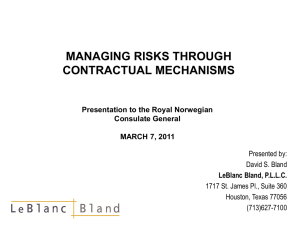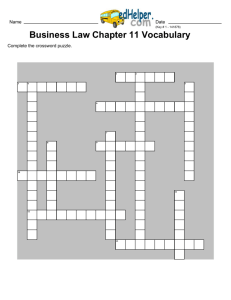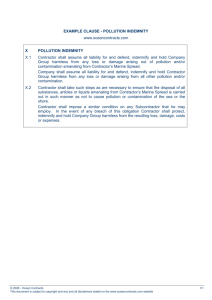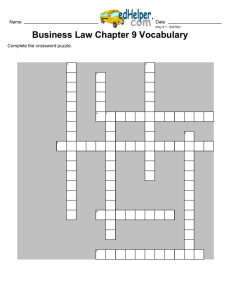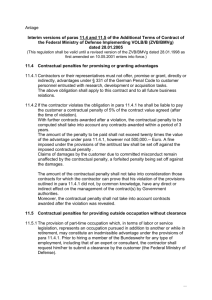Letter Template
advertisement
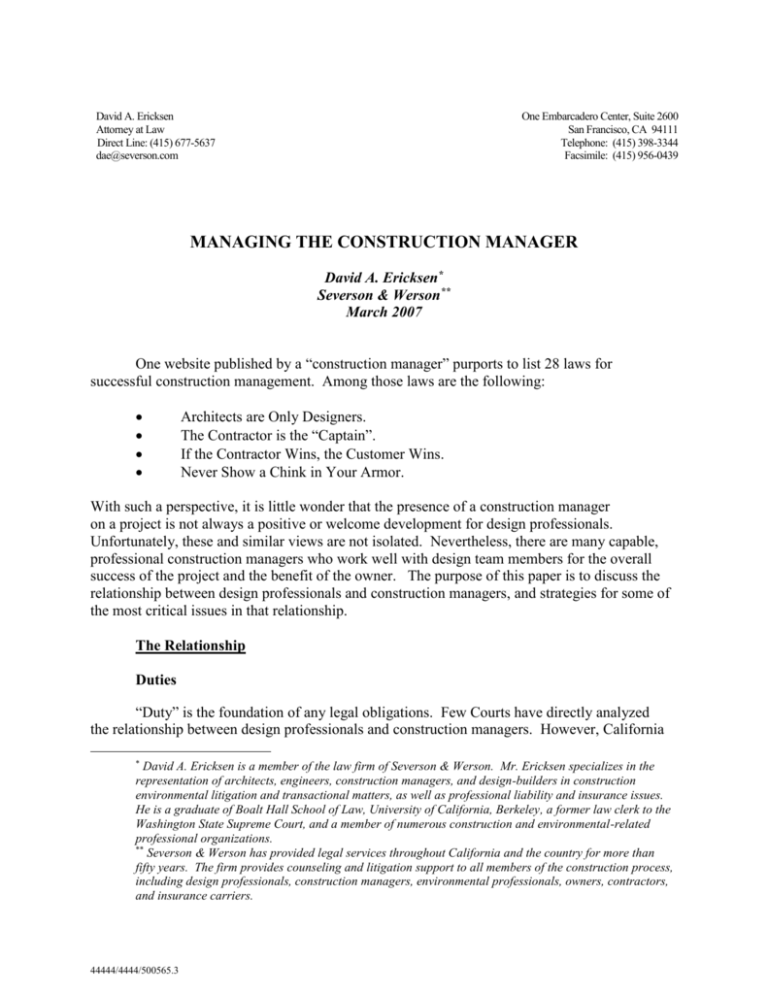
David A. Ericksen Attorney at Law Direct Line: (415) 677-5637 dae@severson.com One Embarcadero Center, Suite 2600 San Francisco, CA 94111 Telephone: (415) 398-3344 Facsimile: (415) 956-0439 MANAGING THE CONSTRUCTION MANAGER David A. Ericksen* Severson & Werson** March 2007 One website published by a “construction manager” purports to list 28 laws for successful construction management. Among those laws are the following: Architects are Only Designers. The Contractor is the “Captain”. If the Contractor Wins, the Customer Wins. Never Show a Chink in Your Armor. With such a perspective, it is little wonder that the presence of a construction manager on a project is not always a positive or welcome development for design professionals. Unfortunately, these and similar views are not isolated. Nevertheless, there are many capable, professional construction managers who work well with design team members for the overall success of the project and the benefit of the owner. The purpose of this paper is to discuss the relationship between design professionals and construction managers, and strategies for some of the most critical issues in that relationship. The Relationship Duties “Duty” is the foundation of any legal obligations. Few Courts have directly analyzed the relationship between design professionals and construction managers. However, California * David A. Ericksen is a member of the law firm of Severson & Werson. Mr. Ericksen specializes in the representation of architects, engineers, construction managers, and design-builders in construction environmental litigation and transactional matters, as well as professional liability and insurance issues. He is a graduate of Boalt Hall School of Law, University of California, Berkeley, a former law clerk to the Washington State Supreme Court, and a member of numerous construction and environmental-related professional organizations. ** Severson & Werson has provided legal services throughout California and the country for more than fifty years. The firm provides counseling and litigation support to all members of the construction process, including design professionals, construction managers, environmental professionals, owners, contractors, and insurance carriers. 44444/4444/500565.3 Managing the Construction Manager March 2007 Page 2 Courts have now specifically examined the relationship between design professionals and construction managers several times in recent years. The leading decision is Vanir Construction Management v. Ratcliff Architects. In that decision, the California Court of Appeal held that absent some commitment and conduct to the contrary, there is no “duty” between a design professional and a construction manager. The Court concluded that each has a direct obligation to the owner and that it would be in conflict with this direct relationship to also have a duty to one another as well. Inherent to this view is the recognition that on some level, design professionals and construction managers are to “watch dog” one another for the benefit of the owner. Such an adversarial relationship is not always healthy and positive. Moreover, construction managers are often much more proactive than design professionals in fulfilling the adversarial portion of the relationship. This is most often to the financial and professional detriment of the design professional. The absence of a recognized “duty” between the construction manager and the design professional has legal significance as well. Absent such a duty, construction managers and/or design professionals may not sue one another directly for professional negligence, errors, and omissions. For example, an architect may not sue a construction manager for costs incurred in redesigning a portion of the project not identified in the construction manager’s constructability review. While a claim for negligence is not available, that does not mean there are not other legal exposures. Those are discussed below. 2. The Contracts The other means for a direct claim between a design professional and construction manager would be based on a duty or obligation established by contract. A contractual obligation may overcome the legal presumption that there is no duty between a design professional and a construction manager. Such duties may be implied or expressed. To avoid any implied and unsuspected obligation, the design professional should always include a provision excluding third-party beneficiaries. It may provide: This Agreement and all related obligations and services are intended for the sole benefit of Owner and Consultant and are not intended to create any third party rights or benefits except as expressly set forth herein. Similarly, the design professional’s contract should expressly set forth an appropriate standard of care, its obligations for Code compliance and construction administration (especially any limitations on such services), and a disclaimer of implied warranties. Each of these apparently generic provisions, or the lack thereof, has been used by construction managers on past projects and disputes to push off responsibility, and even liability, onto the design professional. 44444/4444/500565.3 Managing the Construction Manager March 2007 Page 3 These provisions are common and should be included as a part of almost any Design Agreement. However, when a construction manager is involved, particular provisions often require special attention. The primary purpose of the special attention to these provisions is to avoid confusion, duplication, and gaps in responsibility. First and foremost, if it is known at the time of contracting, the plan to use a construction manager (and even the identity of the construction manager) should be identified in the agreement. If possible, the anticipated functions of the construction manager should be identified in the Agreement along with a statement that the design professional shall not be responsible for such functions or any failure on the part of the construction manager to fulfill those functions. Similarly, the Agreement should provide that the design professional is not responsible for the erroneous interpretation of its documents by others. Implicitly, this makes the construction manager responsible for any erroneous interpretation of the plans and specifications if it does not involve the design professional in that process. Many common provisions in Design Agreements may need to be modified in a situation where a construction manager is involved in the project. For example, a typical job site observation provision makes little sense if there will be a construction manager, or even an inspector of record, with a greater or even continuous presence on the site. Finally, provisions for shop drawings, submittals, RFIs, change orders, and project close-out may need to be modified, depending on the role of the construction manager. Many of the provisions referenced above are plainly for the benefit of the project. They seek to avoid duplication and gaps in responsibility. This is generally to the benefit of the owner and the project. However, there is also certainly an element of “protection” for the design professional in these provisions. Obviously, the construction manager should be motivated to pursue similar protections for itself. Accordingly, a prudent design professional will request a copy of the construction manager’s agreement and will review it. The purpose of this review is at least two-fold. First and foremost, it will educate the design professional as to the construction manager’s contractual role. In this way, the design professional will know what to expect and can proactively “encourage” fulfillment of that role by the construction manager. Second, it will allow the design professional to coordinate its contract and work product with the construction manager’s role. 44444/4444/500565.3 Managing the Construction Manager March 2007 Page 4 3. Joint and Several Liability Even where there is no direct common law or contractual “duty” between the design professional and the construction manager, there can be claims between them and situations of shared liability exposure. Generally, two parties who lack a direct duty or obligation to one another may still be “joint tortfeasors” in that they may share in the liability to a third party, such as an owner or contractor. In this context, the injured party may often pursue just one of the parties for 100% of its damages. It then becomes the obligation of the party sued to seek contribution and indemnity from the other party so that each will share in the liability based on their respective contributions. For example, an architect sued by an owner for errors and omissions in its plans and specifications may sue a construction manager for the failure to identify those errors and omissions in the constructability review. Each would then contribute in proportion to their responsibility to the owner’s damages. 4. Indemnities Without question, the most common obligation between design professionals and construction managers has to do with indemnity clauses. Prudent construction managers and design professionals will often ask owners to require contractual indemnity from other parties as a part of their contracts with the owner. Such provisions may specifically identify the party or may generically refer to the owner’s “agents” or “representatives”. It is not uncommon for reciprocal indemnity obligations to arise in this way. Indemnity provisions are among the most potent clauses in any contract. Generically, they should be limited to proportionate responsibility for the design professional’s actual negligence or breach of contract. Beyond that, the details matter greatly. Each word can make a dramatic and expensive difference. For example, under California law, an indemnity clause covering property damage and bodily injury would by law preclude any indemnity claim for all other types of losses. Accordingly, any non-standard indemnity clause should be reviewed with great care and, ideally, with an attorney knowledgeable in such areas. 5. Division of Responsibility Much of the discussion set forth in Section 2, above, is intended to establish a clear division of responsibility between the design professional and the construction manager. Strategically, this may be the single most important consideration for a design professional starting a project with a construction manager. There are many reasons for this. It seeks to limit joint and several responsibility. It allows for efficient project delivery in that there is limited duplication and no expectation of services which are not actually delivered. If these issues have 44444/4444/500565.3 Managing the Construction Manager March 2007 Page 5 been discussed prior to the contract and serve as a basis for the commitments in the contract, the relevant points in those discussions should be incorporated into the Agreement. Otherwise, the contractual integration clause and the parole evidence rule will make it as if the discussions never took place. However, the contract is really just one method of establishing and maintaining the division of responsibility. It may be established or ratified by subsequent meetings, documentation, and/or correspondence. All measures to establish, maintain, and redefine the appropriate and actual division of responsibility should be pursued throughout the duration of the project. In particular, the design professional should not be shy about reminding both the owner and the construction manager of the construction manager’s responsibilities to see that they are fulfilled and do not shift by default to a service-oriented design professional. Specifically, design staff should be educated as to the construction manager’s role and responsibility, and directed not to voluntarily extend themselves into those areas. 6. Communication The natural corollary is that good contractual language can easily be voided by contrary conduct. If the contract clearly limits the design professional’s responsibility, but later conduct goes beyond that responsibility, the contractual limitations will be of limited value. Such “expanded” services most often arise in site visits, job site meetings, or change order evaluations. Communication is the final key to establishing a successful relationship with a construction manager. Clear lines of communication with all interested parties should be identified and documented. This should include communications with the construction manager, owner, contractor, subcontractor, building officials, and more. The design professional should respect and adhere to these lines of communication. However, with respect to critical communications, the design professional should not assume that their communications are being relayed to all necessary parties. Where the design professional believes the information is critical in terms of substance or timing, the design professional may either confirm the information has been relayed or bypass that necessity by including other essential parties as recipients of copies of the communication. Project Issues 1. Constructability Reviews Constructability reviews are becoming one of the most common services promoted by construction managers. One construction management firm advertises such reviews as follows: 44444/4444/500565.3 Managing the Construction Manager March 2007 Page 6 Constructability reviews are a key to trouble-free projects. The focus is on the buildability, bidability and efficiency of construction. Our reviews bring to light problems in the following areas: reasonableness of the work sequence, comprehensive and completion of construction documents, coordination of the documents among the various engineering disciplines, adequacy of lead time for material and equipment procurement, site restrictions and adequacy of access. This is a tall order for any review. It suggests a thorough review of design issues. However, in reality, it is much more limited from the design team’s perspective. First and foremost, absent a contractual provision to the contrary, the review is not intended for the design professional’s benefit and is not something on which the design professional is legally entitled to rely. Moreover, it is seldom performed by an architect or engineer with technical expertise or experience in the subject under review. Accordingly, design professionals should not place inordinate reliance on this review. Nevertheless, it can be useful in identifying any unresolved issues in the plans and in defending any eventual claims from contractors or others. To secure maximum benefit and protection from the process, design professionals may wish to consider a contract provision discussing the process and their right to rely on it. Such a provision might read: During the course of design and as identified below, Owner’s Consultant will review the plans and specifications for coordination, completeness, consistency, code compliance, and constructability. Designer shall receive written comments as a result of that review and may rely on comments received during that review as a part of its design process and the completion of the design. Alternatively, this may be accomplished in a more benign way by simply providing that the design professional may rely on the work product provided by other consultants retained directly by the Owner. Some of the most important issues to be considered by a design professional whose work will be subject to a constructability review are as follows: The purpose of the review should be identified. Preferably, this will be in the contract, but may also be accomplished by subsequent communications and confirmation. The number and timing of the reviews should also be identified up front. The number and timing of the reviews will impact schedule, fees, and the extent to which they can relied upon for going forward with the design. 44444/4444/500565.3 Managing the Construction Manager March 2007 Page 7 The design professional is not responsible for the content or quality of the review. Including face-to-face discussions as part of the process. 2. Contract Enforcement Most often, enforcement of the contractor’s obligations is the responsibility of the owner and construction manager. Typically, the construction manager will supplant any role the design professional might have otherwise had in administering the contractor’s agreement. However, this is seldom ever documented and is even less often reflected in the contract documents. It should be, since the failure to do so is most often to the detriment of the project and the design team. Accordingly, the contract should provide: The design team has relied on the obligations set forth in the Owner/Contractor agreement as a material term of its performance under this Agreement. Except for technical design issues requiring the input of the architect or engineer, the Contractor’s obligations under its Agreement with Owner shall be administered and enforced solely by the Construction Manager. The design team shall have no responsibility for issues arising out of the failure to enforce that Agreement and shall be indemnified, defended, and held harmless from any claims arising out of such failures. Thereafter, the design team should perform consistent with this standard and should remind the construction manager of failures by the contractor and its obligation to enforce the Agreement. 3. RFIs RFIs are a difficult issue in dealing with a construction manager. The first issue is the procedure. Will they be routed through the construction manager? If so, will the construction manager seek to answer any of the RFIs itself without the design team? These procedures need to be worked out in advance with the Agreements documented. Furthermore, the design agreement should provide that the design team will not be responsible for erroneous interpretations of its design documents by others. 4. Change Orders Change orders are fraught with potential liability issues in any context. They seem to be even more so when a construction manager is involved. These most often arise for two reasons: 44444/4444/500565.3 Managing the Construction Manager March 2007 Page 8 a. The construction manager is often responsible for the entitlement, schedule, and compensation issues, but the design professional is not clearly segregated from that process; and b. Many construction managers will often assign “responsibility” for the issue, and it most often weighs heavily against the design team and does not reflect any “standard of care” analysis. Accordingly, the design team should expressly and consistently clarify that it is not responsible for schedule and compensation issues. This can and should be in the contract, related correspondence, and the change order itself. In addition, the design team should create and even provide its own contemporaneous allocation of the source of the change order. Absent such a contemporaneous record, the construction manager’s record will become the owner’s assumption as to the cause of the change and difficult to refute. 5. Job Site Observations Where there is a construction manager or inspector of record, it is simply not appropriate to have a typical job site observation responsibility for the design team. It should be more limited. Specifically, it should be limited to observation of technical design issues on a stated timetable and other issues as specifically addressed to it by the construction manager. It should not involve and should exclude responsibility for payment, schedule, material, and similar issues. 6. Project Documentation Finally, a construction manager often becomes the primary source of project documentation. This may be appropriate if established in the contract documents. However, design professionals should rigorously avoid any temptation to rely solely on the construction manger for documentation of the construction process. Specifically, design professionals should: a. Fulfill their contractual obligations for project documentation; b. Review project documentation created by others to make certain it is balanced and accurate. Where it is inaccurate or slanted against the design professional, they must respond in writing to avoid a subsequent unbalanced record; c. Maintain their own history of the project through reports and memos. Absent such records, the records of others will be the only credible project history and will likely be slanted to the interests of others. 44444/4444/500565.3 Managing the Construction Manager March 2007 Page 9 CONCLUSION In summary, design professionals working with construction managers must: a. Be careful to establish and adhere to the respective roles; and b. Avoid abdication of their professional and contractual responsibilities. Used by permission of the author, David A. Ericksen, Esq. Do not reproduce or distribute without express permission from the author. 44444/4444/500565.3
